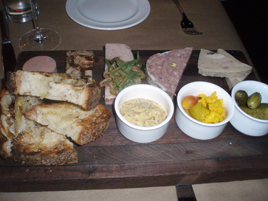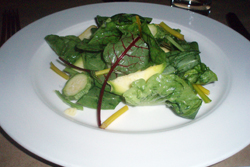The Breslin
 Friday, July 30, 2010 at 03:45PM
Friday, July 30, 2010 at 03:45PM 
I visited The Breslin alone about a month ago. I felt it was a two-star restaurant at the time, but hadn’t sampled enough of the menu to form a definite impression. Now I can correct that (and Sam Sifton’s wrong-headed one-spot).
I wrote about the background of The Breslin in an earlier review, so I’ll get right to the food.


The Terrine Board (above left) is excellent—the components being guinea hen, rustic pork, rabbit & prune, liverwurst, and head cheese. I wonder why there is no option for a solo diner? It comes in two sizes ($25 or $42), and even the smaller one, which we had, is too large for one person.
A whole trout ($32; above right) was exquisite, its pink flesh moist and tender. We also had the lamb burger and fries once again (the photo is in my earlier review), which was as good as before.
The wine list is a tad expensive, with too few bottles under $50. However, the 2007 Domaine des Martinelles at $55 was wonderful. The list describes it as “the rustic side of Crozes-Hermitage: meat-driven, earthy, funky, and amazingly yummy.” It arrived at the table properly chilled. Even restaurants much more expensive than The Breslin often serve red wine at room temperature.
I don’t know how Chef April Bloomfield divides her time between The Breslin and her other restaurant, The Spotted Pig. She was in the Breslin kitchen the night we were there, apparently (as far as we could tell) looking at every plate that went out.
The space is noisier than I’d like, and I wish they took reservations. The dining room hasn’t been full either time I visited (the packed bar is another story entirely). Perhaps it would even help business to get with the program, and join OpenTable. But I love April Bloomfield’s food too much to subtract points for that, so The Breslin gets two stars from us.
The Breslin (16 W. 29th Street between Broadway & Fifth Avenue, West Midtown)
Food: **
Service: *½
Ambiance: *
Overall: **


































